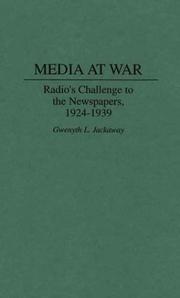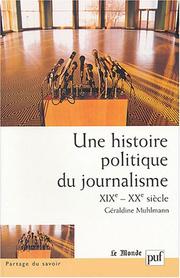| Listing 1 - 4 of 4 |
Sort by
|

ISBN: 0275952576 9780275952570 Year: 1996 Publisher: New York (N.Y.): Praeger,
Abstract | Keywords | Export | Availability | Bookmark
 Loading...
Loading...Choose an application
- Reference Manager
- EndNote
- RefWorks (Direct export to RefWorks)
Book
ISBN: 9780190492342 9780190492335 0190492341 0190492333 Year: 2018 Publisher: New York, NY: Oxford university press,
Abstract | Keywords | Export | Availability | Bookmark
 Loading...
Loading...Choose an application
- Reference Manager
- EndNote
- RefWorks (Direct export to RefWorks)
From data-rich infographics to 140 character tweets and activist cell phone photos taken at political protests, 21st century journalism is awash in new ways to report, display, and distribute the news. Computational journalism, in particular, has been the object of recent scholarly and industry attention as large datasets, powerful algorithms, and growing technological capacity at news organizations seemingly empower journalists and editors to report the news in creative ways. Can journalists use data-along with other forms of quantified information such as paper documents of figures, data visualizations, and charts and graphs-in order to produce better journalism? In this book, C.W. Anderson traces the genealogy of data journalism and its material and technological underpinnings, arguing that the use of data in news reporting is inevitably intertwined with national politics, the evolution of computable databases, and the history of professional scientific fields. It is impossible to understand journalistic uses of data, Anderson argues, without understanding the oft-contentious relationship between social science and journalism. It is also impossible to disentangle empirical forms of public truth telling without first understanding the remarkably persistent Progressive belief that the publication of empirically verifiable information will lead to a more just and prosperous world. Anderson considers various types of evidence (documents, interviews, informational graphics, surveys, databases, variables, and algorithms) and the ways these objects have been used through four different eras in American journalism (the Progressive Era, the interpretive journalism movement of the 1930s, the invention of so-called "precision journalism," and today's computational journalistic moment) to pinpoint what counts as empirical knowledge in news reporting. Ultimately the book shows how the changes in these specifically journalistic understandings of evidence can help us think through the current "digital data moment" in ways that go beyond simply journalism.
Journalism --- Attribution of news. --- History --- Objectivity. --- Data processing. --- Technological innovations. --- Journalism - History - 20th century. --- Journalism - History - 21st century. --- Journalism - Objectivity. --- Journalism - Data processing. --- Journalism - Technological innovations.

ISBN: 2130539394 9782130539391 Year: 2004 Publisher: Paris: PUF,
Abstract | Keywords | Export | Availability | Bookmark
 Loading...
Loading...Choose an application
- Reference Manager
- EndNote
- RefWorks (Direct export to RefWorks)
Press and politics --- Investigative reporting --- Journalism --- Presse et politique --- Journalisme d'enquête --- Journalisme --- History --- Histoire --- Political aspects --- Journalistiek ; geschiedenis --- Political aspects. --- Journalisme d'enquête --- Journalism - History - 20th century --- Journalism - History - 19th century --- Journalism - Political aspects
Book
ISSN: 13784099 ISBN: 9782804162412 2804162419 Year: 2010 Volume: *28 Publisher: Bruxelles De Boeck Université
Abstract | Keywords | Export | Availability | Bookmark
 Loading...
Loading...Choose an application
- Reference Manager
- EndNote
- RefWorks (Direct export to RefWorks)
Qu'on les nomme correspondants étrangers, correspondants de guerre, envoyés spéciaux ou grands reporters, ce livre donne la parole à trois générations de journalistes qui ont couvert l'étranger pour le compte de l'Agence France-Presse.Le modèle journalistique de l'AFP étant une référence dans le métier, la production de ses journalistes - notamment à l'étranger où l'AFP dispose dun large réseau de couverture - mérite une attention toute particulière, d'autant que l'agence reste aujourd'hui encore l'un des principaux pourvoyeurs d'information pour de nombreux médias. Guerre du Vietnam, guerre d'Algérie, coups d'états en Amérique latine, chute du mur de Berlin, attaque du World Trade Center, conflit israélo palestinien, ... Ces journalistes ont vécu et raconté sans relâche les grands événements des XXe et XXIe siècles sous le couvert de l'anonymat, l'une des règles de l'AFP.À travers leurs témoignages, l'ouvrage propose une analyse du processus global de transformation du journalisme et de la nature de ces évolutions de 1945 à nos jours en se fondant sur le concept de configuration développé par le sociologue Norbert Elias. L'auteure examine successivement la modification du contexte de production de l'information avec la transformation des techniques de communication, de l'entreprise de presse, de ses clients et l'apparition de nouveaux acteurs médiatiques. Elle présente ensuite l'évolution de l'identité professionnelle et personnelle des journalistes. Enfin, elle analyse les transformations du concept d'information à travers l'évolution des formats et des contenus et celle du modèle journalistique.Bron : http://superieur.deboeck.com
Journalism --- History --- Agence France-presse --- Foreign correspondents --- War correspondents --- Correspondants étrangers --- Correspondants de guerre --- Professional ethics --- 1945 --- -Agence France-Presse --- -Journalism --- -Foreign correspondents --- -Journalistiek --- Internetjournalistiek --- Nieuwe media --- Geschiedenis --- Nieuws --- Internationalisering --- Journalistiek --- Geneeskunde --- Techniek (wetenschap) --- Atlas --- Museum --- Reizen --- Ziekte --- Vliegen (werkwoord) --- Journalism - France - History - 20th century --- Journalism - History - 20th century --- Journalisme --- Correspondants à l'étranger --- 1945-....
| Listing 1 - 4 of 4 |
Sort by
|

 Search
Search Feedback
Feedback About UniCat
About UniCat  Help
Help News
News